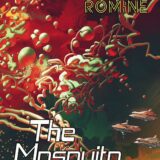 The Rings of Ganymede, by Kendall Evans
The Rings of Ganymede, by Kendall Evans
Alban Lake Publishing – www.albanlake.com
I literally just finished this wonderful book. I’ve been planning on reviewing it here in any case and I’m delighted to do so today. This is unlike any book you’ve read before and yet it feels so familiar. It is a play in verse, so its syntax and rhythm are much like a Shakespeare play. It’s also Space Opera and as is typical in that sub-genre the narrative spans the galaxy, ventures into alternative realities and even gives a good mind-boggle with time dilation as well. It is populated with aliens and demi-gods, “mythical” creatures and Artificial Intelligences. This is a fantastic mash-up with a Ring of Power, ill-fated lovers, Mermaidens and Mermen, winged aliens, robots and an Enigma behind it all. In short, this story is a grand romp, which is impossible not to enjoy. The story follows The Ring of the Nibelung (the opera cycle by Richard Wagner), but only loosely. There is the Ring, which the New god Rotan seeks to wear in the first book and then wields throughout the rest of the cycle. There are the Valkyrie, which in Evan’s Ring Cycle are female winged aliens, who are often portrayed as warriors. There’s even a bit of incest as Siegmund with Sieglinde in Wagner’s Ring, there’s Rotan and his daughter Sieglinda in Evans’. And in the fourth book The Rings of Ganymede there’s a Götterdämmerung, just like in Wagner’s. That’s pretty much where the gross similarities end, but it’s fun to find the small details, if you know what you are looking for.
 Before I started reading, I was afraid I would have a hard time getting into it. So, while Evans’ poetry is in a style like Shakespeare’s (although it’s not in iambic pentameter, the length of the lines evokes the same feeling), it is easy to read and once you’ve read a few pages you’ve become accustomed to the rhythm and it becomes second nature. The dialogue is interspersed with “stage” direction or rather a director’s film directions, which give you a break from the verse. I only wish there had been more consistent inclusion of when the scene was taking place. How many months or years have passed? It became clear as you read, but I found myself puzzling about it often enough. The directions give describe the scene, elaborate on the character’s emotional state or the way they look (and have changed) and create a little movie in your head. I loved it.
Before I started reading, I was afraid I would have a hard time getting into it. So, while Evans’ poetry is in a style like Shakespeare’s (although it’s not in iambic pentameter, the length of the lines evokes the same feeling), it is easy to read and once you’ve read a few pages you’ve become accustomed to the rhythm and it becomes second nature. The dialogue is interspersed with “stage” direction or rather a director’s film directions, which give you a break from the verse. I only wish there had been more consistent inclusion of when the scene was taking place. How many months or years have passed? It became clear as you read, but I found myself puzzling about it often enough. The directions give describe the scene, elaborate on the character’s emotional state or the way they look (and have changed) and create a little movie in your head. I loved it.
With the help of Robert Neufeld, I’ve recorded two scenes from the first book of the play – The Mermaidens of Ceres. Have a listen to Act I, Scene 3 and Act II, Scene 1:
Audio Player
Now wasn’t that fun? Evans has done well creating an enjoyable play in verse, the characters are distinct and well-rounded, the visual aspect is very clear. The verse works so well with the subject matter even if you can’t imagine it could be so. If I have anything to gripe about it would be that in putting the four books together, some of the repetitions of character descriptions or settings could’ve (should’ve) been eliminated. There were also many typos. I read slow enough that I always notice typos and inconsistencies and there were too many in this book. Oh, and the cover. The cover! It’s too busy and pretty cheesy. I’m not a big fan of scantily clad women on SF covers. This one belongs to the type of cover I would try to conceal.











Recent Comments